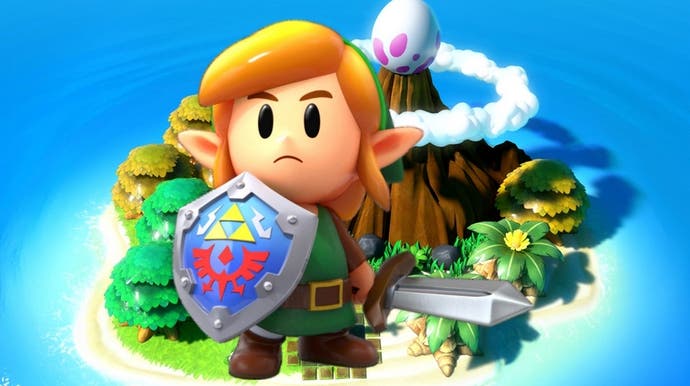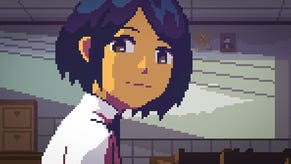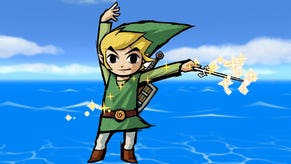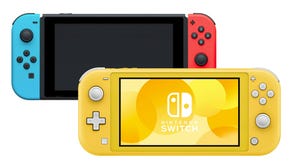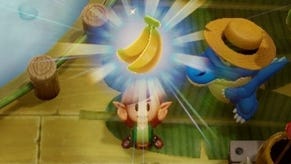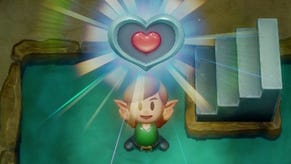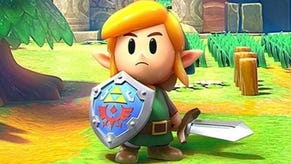The Legend of Zelda: Link's Awakening Switch review - a dream come true
Tal Tal signs.
Koholint Island is a place worth treasuring. This is something Link learns over the course of his quest to wake the mythical Wind Fish. And it's something you will know already if you have played either version of Link's Awakening to date: the Game Boy original or its DX re-release for Game Boy Color. Koholint Island is as much a character in Link's adventure as its inhabitants, and not a square of its map is wasted. From the beach Link washes up on to the purple and white egg laying in wait on its highest peak, it is a meticulously-made puzzle wrapped up in the lives of those who dwell upon it.
Zelda has frequently dealt in melancholy, via locations on the brink of doom or left recovering from it generations later. On the surface, Link's Awakening is one of the series' most whimsical entries, its world inhabited by Super Mario enemies and talking animals, frogs who sing soul music and crocodile artists who paint pictures. But, from the off, it is also a location Link knows he must escape from - even if he doesn't yet know why. The melancholy here lies in every subsequent step, each bringing a greater familiarity and understanding of the places and people he must leave behind.
All this was true, of course, when Link's Awakening launched as a full-blooded Zelda game squished down onto a tiny monochrome screen, but crucially it remains so now on Nintendo Switch, where this masterly remake arrives in a post-Breath of the Wild world. All these years later, this version is exactly what I had hoped for - a chance to play through a modern recreation of Koholint's original design, laid out exactly as it was and without any of its oddball charm being lost on the way. It's an astonishing balancing act to see the remake's choice of new visual style - tactile terracotta buildings and model-like figures cast against bokeh-drenched backgrounds - so accurately preserve the original's quirks. The side-scrolling sections remain intact, as do the rooms which reset after you leave them, in a replication of the effect seen on the Game Boy, when that version's grid-based layout scrolled from one screen to the other. For Link's Awakening fans, this remake feels like the game you dreamt of.
For those new to the game - and for Link himself, of course - Koholint is an island full of secrets awaiting discovery. There's something Breath of the Wild-like to its largely open structure - most of its regions are accessible after the game's first hour - and in the uncertain nature of how Link has found himself here, a place which feels oddly familiar. But in its gameplay and item design this is classic Zelda, with a sizeable overworld - perhaps the series' tightest - and a selection of dungeons housing new items to let you puzzle a little further than before. Along the way, Link will befriend the inhabitants of Mabe Village and the wider island, aid them in their struggles, bring love to a goat pretending to be Princess Peach, and even travel with a few of them as they explore alongside you.
Talk about melancholy in Zelda and I can't help but think of Marin, the islander who finds you washed up on the shore. As the game progresses, you learn of her desire to leave the shores of Koholint also - and you see the lengths she'll go to do it. The all too brief scenes of her and Link taking a moment from their adventures to simply stare at the ocean together are the heart of this game, and the sequence where she accompanies you on your quest is still one of my favourite moments of the entire series. This section is highlighted in this remake by subtle changes to the game's brilliant new orchestral score, which also provides several new best versions of the Tal Tal Mountains theme, quite simply one of the greatest pieces of video game music ever recorded.

Now's as good a time as any to talk briefly about the game's DX additions, most of which are are also included intact. The Color Dungeon always felt a bit like a DVD extra, and its return here proves this high-def release has been designed to leave as little as possible on the cutting room floor. Game Boy Printer support has, somewhat understandably, been retired - and with it the in-game photos you could collect at certain points in the game's plot. But, speaking of Marin, it's fair to say that fans who know where to go and when will be duly rewarded.
In the Printer shop's place is the remake's new Chamber Dungeon creator, a far more creative distraction which lets you slot together rooms from dungeons you've beaten to craft challenge maps. Sure, it doesn't quite provide the same level of customisation as Mario Maker - but its surprisingly straightforward editor lets you quickly build the Lego blocks of Link's Awakening dungeons into new and increasingly complicated designs. Ocarina of Time's graveyard keeper Dampé serves as your host, setting you new challenges to create and complete maps around particular objectives and floor layouts - and pretty soon you can start adding greater variety to your builds, with the option for dungeons with time or health limits, restrictions to the use of items such as your sword, or modifiers to rain bombs. Every time I completed a dungeon I would warp over to Dampé and see what new challenges he had to offer, and spend a while there to unlock further rooms and other rewards. The only downside is the inability to share creations with others online, though designs can be saved and passed on via amiibo.
Nintendo's remake - handled by Grezzo, the same team which escorted Ocarina and Majora so well onto 3DS - is otherwise extraordinarily faithful. Every secret you might remember of Koholint Island remains intact - that bush which always grants hearts, that tree you can slam into to make a secret fall from its leaves, that rock under which lurks a creature who will increase your inventory size - with a few more things sprinkled on top. There are new decorations to win from the Trendy Game, more reasons to fish and ride the rapids, and significantly more Secret Seashells to hunt down with a useful (and optional) tool to aid in your search for those, if you so choose.
What other tweaks there are consist of small quality of life changes which fans may notice, while newcomers will unknowingly appreciate. Most obvious are the game's controls, and the time saved not having to constantly swap equipped items since many of these are now permanently mapped to the Switch's extra buttons. Finally, and somewhat anecdotally, the game also feels far more generous with rupees (so you don't have to do that thing to avoid a long grind for early game money).
I first played Link's Awakening in black and white, more than 20 years ago, but it coloured my hopes for every Zelda since. Some frame-rate issues on the overworld at launch aside - more an annoyance than anything else - this version surpasses the hopes I had for another visit to its world. Koholint Island deserves nothing less, and while Link must journey to leave its shores, this remake will always be a place which preserves the island for others to follow.
